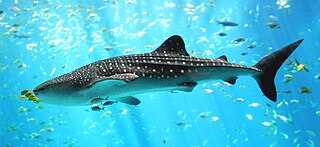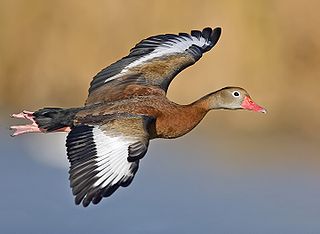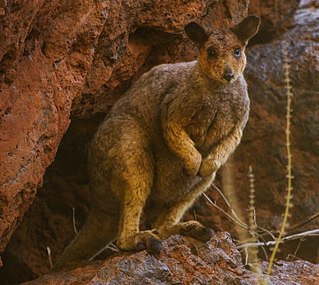
Requiem sharks are sharks of the family Carcharhinidae in the order Carcharhiniformes. They are migratory, live-bearing sharks of warm seas and includes such species as the tiger shark, the spinner shark, the blacknose shark, the blacktip shark, the grey reef shark, the blacktip reef shark, the silky shark, the dusky shark, the blue shark, the copper shark and the oceanic whitetip shark.

Carpet sharks are sharks classified in the order Orectolobiformes. Sometimes the common name "carpet shark" is used interchangeably with "wobbegong", which is the common name of sharks in the family Orectolobidae. Carpet sharks have five gill slits, two spineless dorsal fins, and a small mouth that does not extend past the eyes. Many species have barbels.

The whistling ducks or tree ducks are a subfamily, Dendrocygninae, of the duck, goose and swan family of birds, Anatidae. They are not true ducks. In other taxonomic schemes, they are considered a separate family, Dendrocygnidae. Some taxonomists list only one genus, Dendrocygna, which contains eight living species, and one undescribed extinct species from Aitutaki of the Cook Islands, but other taxonomists also list the white-backed duck under the subfamily.

François-Louis Nompar de Caumont Laporte, comte de Castelnau was a French naturalist, known also as François Laporte or Francis de Castelnau. The standard author abbreviation Castelnau is used to indicate him when citing a botanical name and zoological names other than insects. Laporte is typically used when citing an insect name, or Laporte de Castelnau.

The genus Eligmodontia consists of five or six species of South American sigmodontine mice restricted to Bolivia, Chile, and Argentina. Species of Eligmodontia occur along the eastern side of the Andes Mountains, in Patagonia, and in the Chaco thorn forest of South America. They can be found in arid and semiarid habitats and in both high and low elevation areas. These rodents are commonly known as gerbil mice or by their local name lauchas. Sometimes they are also called silky desert mice, highland desert mice or silky-footed mice. The closest living relatives are probably the chaco mice (Andalgalomys), the leaf-eared mice, and Salinomys.

Negaprion is a genus of requiem sharks in the family Carcharhinidae. It contains the two extant species of lemon sharks: the lemon shark of the Americas, and the sicklefin lemon shark of the Indo-Pacific. Both species are large, slow-moving, bulky sharks inhabiting shallow coastal waters, and can be identified by their short, blunt snouts, two dorsal fins of nearly equal size, and uniform yellowish brown or gray coloration.

The rock-wallabies are the wallabies of the genus Petrogale.
The Botanical and Zoological Codes of nomenclature treat the concept of synonymy differently. In botanical nomenclature, a synonym is a scientific name that applies to a taxon that (now) goes by a different scientific name. For example, Linnaeus was the first to give a scientific name to the Norway spruce, which he called Pinus abies. This name is no longer in use: it is now a synonym of the current scientific name, Picea abies. In zoology, moving a species from one genus to another results in a different binomen, but the name is considered an alternative combination, rather than a synonym. The concept of synonymy in zoology is reserved for two names at the same rank that refer to a taxon at that rank - for example, the name Papilio prorsaLinnaeus, 1758 is a junior synonym of Papilio levanaLinnaeus, 1758, being names for different seasonal forms of the species now referred to as Araschnia levana(Linnaeus, 1758), the map butterfly. However, Araschnia levana is not a synonym of Papilio levana in the taxonomic sense employed by the Zoological code.

The common green frog is a frog species of in the true frog family Ranidae; some sources still use the old name Rana erythraea. It lives in Southeast Asia and is also known as green paddy frog, red-eared frog or leaf frog. The last name, however, commonly refers to the Neotropical tree frogs which make up the subfamily Phyllomedusinae. These are not closely related to H. erythraea, belonging to family Hylidae instead.

The brown-tailed mongoose, Malagasy brown-tailed mongoose, or salano is a species of mammal in the family Eupleridae. It is endemic to Madagascar. Its natural habitat is subtropical or tropical dry forests. It is threatened by habitat loss.

Homosteus is a genus of flattened arthrodire placoderm from the Middle Devonian. Fossils are found primarily in Eifelian-epoch aged strata of Europe, Canada, Greenland, and Estonia. All of the species had comparatively large, flattened heads with, as suggested by the upward opening orbits, upward-pointing eyes. These adaptations suggest that the various species were benthic predators. A study on Titanichthys, in contrast, suggests that species of Homosteus may have been filter-feeders instead.

Enidae is a family of air-breathing land snails, terrestrial pulmonate gastropod mollusks.

Modiolus, the horsemussels, are a genus of medium-sized marine bivalve molluscs in the family Mytilidae.

Pristiophorus is a genus of sawsharks found in the Pacific, Atlantic and Indian oceans. Members of this genus differ from the Sixgill Sawshark (Pliotrema warreni) in having five gill slits. Their rostral sawteeth lack prominent transverse ridges on the basal ledges, and the large teeth are not posteriorly serrated.
Batrachosaurus is an extinct genus of prehistoric brachyopoid amphibian that lived in Germany during the Middle Triassic (Ladinian). The genus was named by Joseph Fitzinger in 1837 and the type species, B. jaegeri, was named three years later in 1840. It may have been the same animal as Mastodonsaurus.
Toxoderidae is a family of praying mantises.

Daphne blagayana is a species of plant in the genus Daphne. It was discovered in 1837 near Polhov Gradec by Heinrich Freyer and named after the botanist Rihard Blagaj.
Liopteridae is a family of wood-boring parasitoid wasps. They occur worldwide with concentrations in the African Tropics. These insects have a petiolate abdomen. There are 10 genera and more than 140 species known.
Metaperipatus is a genus of velvet worms in the family Peripatopsidae that contains the species Metaperipatus inae. The type locality is in central Chile.













